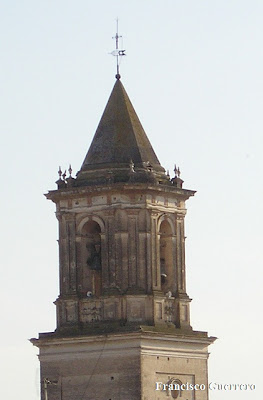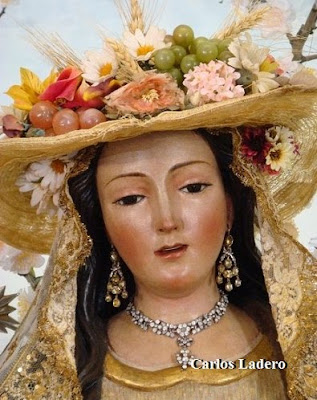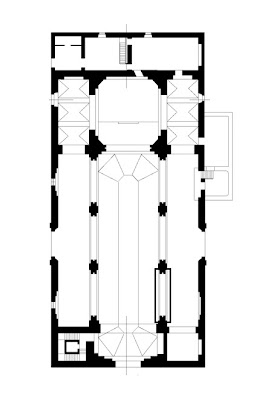Pastoreña Parish (IV) The eighteenth century: the golden age of parish Pastoreña

In the first of the next century comes a historical fact that will influence the way decisive and to this day will mark the passing of people and his parish: the beginning of devotion to the Divine Shepherdess and the foundation of her rosary in her or brotherhood. Cantillana
had the immense luck to be one of the towns or cities that first embraced this new invocation of the Virgin, born in 1703 in Seville. In official documents , 1805 and 1806 to collect testimonies of the then parish priest and mayor of Cantillana, it appears that "the establishment of the Rosary in the parish pastor is from time immemorial and there are no agreed or Cantillana who has known the principle of the "and" has been established a long time now in this town, holding this devotion at the expense of their neighborhood. " It would then go back over 60 or 70 years ago to place the birth of the brotherhood Pastoreña of this town and the origin of the cult of the owner, are considered parallel events. It is therefore entirely plausible that the contribution in this regard made by the priest when he reports chronicler Alonso Morgado, speaking of the first foundations of the venerable father pastoreñas Guild Isidoro, "no less famous was the village of Cantillana for the years from 1720."
This is the date that also supports the secular oral tradition and the church officially recognized as the canonical erection of the brotherhood, because no evidence ever put into question, but quite the opposite. Moreover, you can check physically, as discussed in the previous chapter in the two relics are kept, preserved and revered since the founding era inside the temple, the pilgrim image of the Divina Pastora and its primitive Simpecado, works , no doubt, scholars have long recognized as characteristic of the first quarter of the eighteenth century, evidence so clear that it did not, to them, but surrender.
But perhaps one might ask what I do now, knowing Cantillana situation at that time, a small village of no more than a thousand inhabitants, is the father decides it Isidoro establish the cult of the Divine Shepherdess founding in parish brotherhood, when their goals in spreading this new urban patronage came to be bigger and more important (Sevilla, Carmona, Ecija, Utrera, Jerez de la Frontera, Aracena, Ronda, Cádiz ...) And how, given the inhabitants encases and resources available to our people and the ignorance and uprooting even by the masses of the new Marian title, could be acquired as quickly as an image of high quality and artistic merit, build his altar in the parish and rich materials make with other objects for their honor and worship, before which noted the staff and a silver tiara and the interesting Simpecado of the same metal wall and painting attributed to Germain Llorente for the rosary.
It has been suggested by various authors, and it seems obvious that what brings Cantillana Fray Isidoro is your relationship, the male line, with the counts and lords of the town, the then patron of the parish. It is therefore very unlikely to be the Leca-specific Vicentelo Manuel de Baeza Vicentelo Leca and Silva, who held until mid-eighteenth century the title of 4th Earl of Cantillana, inherited from his father who was governor of the Alcazar of Seville, which led to this town and parish were targeted missionary Fray Isidoro and they , his patronage and sponsorship, as the apostolic work of his relative cappuccino, were granted and have to thank you forever, which is primarily Cantillana pastoreña and its main church was erected one of the most famous and fervent fraternity of Divina Pastora. The cult
Pastora eighteenth century know little more than what can be deduced from the documents of the early nineteenth century to which I alluded earlier. We know that his "pilgrim image was placed on the altar with enough decency in the parish church" and had "provided with your party on Sponsorship" for sacramental fellowship, which paid "annually for 24 real function, whose sermon was instead "it was paid for by the director of the rosary." The public recitation of this was precisely the most frequent activity and rooted in brotherhood and would now common in those years the picture of feminine rosary Pastor "the one who has been in Cantillana" according to testimony in 1805, leaving the parish and through all the Sundays and holidays "and afflictions and calamities" the streets of Cantillana as it did in 1800.

La Divina Pastora, image with greater seniority and devotion in the parish of Cantillana, where interruption is worshiped at his altar since the early eighteenth century.
The gilded wooden cross that appears in the inventory of 1807, the old brass lanterns and Simpecado founding of crimson velvet, gold braid and silver appliqués overlapping even paint or stamp of the Divine Shepherdess , attributed to Germain Llorente, were kept in the temple "in three shelves at the baptismal chapel." The place occupied by the altar with the image of the Shepherd, attributed to Gijón, unknown, as are the characteristics of his first altarpiece, although we could identify with the altarpieces of the early eighteenth century, which now houses the statue of Our Lady of Pilar, in 1937, after the Civil War, was taken from the hermitage Mercy to the parish, which might be their original location. According
Pineda Novo wrote "In the niche of the altarpiece are some simple but curious paintings of angels in a circle-seven cherubs against a background or landscape with a little sheep and San Miguel, which indicate that he received the strange cult image of the Divina Pastora in the eighteenth century. It also gives the chance that in the altarpiece, inside the half way point that the niche can be seen painted in four caissons or brackets, the same emblems Marian: sun, moon, palm and cypress, which owns the original Simpecado the Divina Pastora. This leads us to assert, as stated Pastora Rivas Solis, Pastor waitress, who in turn had heard from his aunt Pastora Solis Villalobos, the ratio of the image of the Pastor to this altarpiece is not accidental and that could consider the first in which this image was worship in the parish, before being transferred to the old chapel of Mercy, which could have happened on 1836, when the brotherhood of Pastor is given a larger altarpiece , extinct from the Franciscan convent of Aguas Santas Villaverde, as discussed in a later chapter.
As described by the archbishop's visit in 1707 we know that the temple architecture and modern factory has ties woody cover in the central nave, the side of decent simple woodwork and vaulted chapel and a chapel, the Sagrario that is to your right. The altarpiece is decent, but not for lack of gold and was at the expense of the charity of neighbors and had gold at the expense of them had not been time as dire. The big failure has this church and that is still very serious problems is lack tower, for which reason the bells and be lower than the height of the church are not heard in most of the place. "
For many years the parish was to continue with this" big failure "that supposed lack of tower , who was from the mid seventeenth century without end not having "more than half done." would have to wait until the end of the century before us so that in the course of a major restoration, extension and ornamentation of the building parish, was topped the strong and elegant finish off a square tower octagonal belfry with four holes to bells and spire, as designed by architect Antonio Diego Diaz, clear example of religious architecture in the prevailing neoclassical Sevilla of the time.
is known that these works, executed in 1784, funded by Cardinal Solis and directed by the master builder of the Archbishop José Álvarez you were supposed to the temple an image change it more suited to the aesthetics of those years. The richly decorated plasterwork, the vaults of the side chapels of the head, the construction of the sacristy and the altar were implementing several projects undertaken restoration work building and tower.

Torre neoclassical church of Cantillana, emblem and icon of the villa, designed by the architect Antonio Díaz Diego about 1784.
is very likely that in the course of these great works of renovation and enhancement, was also thrust an important company of golden altarpiece, which since its implementation in 1700 had remained in wood, taking the gold only tabernacle and manifesting. The full gold is not completed until 1790 and it involved the master gilder and carver Diego Manuel Rodríguez Cayetano Ruiz, as reflected in his work the historian Francisco Herrera García.
The magnitude of the works undertaken in the parish during the years of the late eighteenth century, who made Morgado and chroniclers as Matute exaggerated to the point of stating that Cardinal Solis "rebuilt from the ground up churches Brenes, Villaverde and Cantillana, more dignity in it spent 239,740 reales, should inevitably lead to the closure of the temple worship during the period (five years or so) that lasted the same. During those years may exert a parish other temples of the town, as the chapel of St. Bartholomew and "church formerly served in the meantime that the new church was built is now parish or of Mercy, in which , because of its proximity, might receive worship during the time of the works the venerated image of the Divina Pastora.
work finished, the temple opened for worship again with more splendor than ever, today completed its design definitely and certainly rejuvenated and enriched in their interiors and altars. This would host
exceptionally, and for some years to the beautiful picture of our patron saint, the Virgen de la Soledad, that while he built his new neoclassical chapel, completed in 1792, received the veneration of the cantillaneros in the parish. La Divina Pastora
at home continue to receive the worship that "since ancient times" it had been taxed and the rosary or brotherhood, the government then Dona Elena de la Barrera and Morales, continue running with devotion foundational practices, enshrining the holder on its main function of sponsorship, removing and installing the rosary in their major cults and the cumbersome and SIMP Risco, which will have the first written in 1807 when it was common assembly. We
1800, the year of the famous yellow fever epidemic that excited even more devotion to the Divine Shepherdess. Of the parish, in the period since then crucial to the mid-nineteenth century, see the following chapter of this story.








